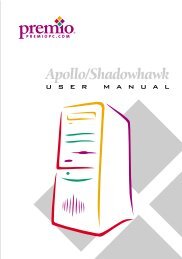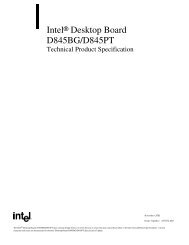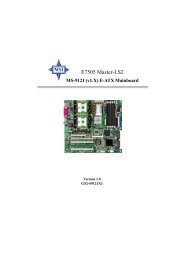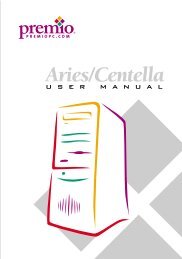Athena System Manual - Premio, Inc.
Athena System Manual - Premio, Inc.
Athena System Manual - Premio, Inc.
Create successful ePaper yourself
Turn your PDF publications into a flip-book with our unique Google optimized e-Paper software.
Troubleshooting<br />
3. Bugs are found<br />
4. Customer-specific request<br />
When we release a new BIOS, there's usually a release note attached which<br />
lists the reason for the release. Refer to this release note and decide for<br />
yourself if upgrading to the new BIOS will be worth it. A word of advice,<br />
though, do not upgrade to the new BIOS, unless you really have to.<br />
Q: How do I update the BIOS?<br />
A: Please refer to http://www.msi.com.tw/support/bios/note.htm for details.<br />
Q: How do I identify the BIOS version?<br />
A: Upon boot-up, the 1st line appearing after the memory count is the BIOS<br />
version. It is usually in the format:<br />
1. For older model number:<br />
AG76 091096 where:<br />
1st digit refers to BIOS maker as A = AMI(R) W = AWARD(R) P = PHOENIX<br />
(R).<br />
2nd digit refers to the internal chipset code.<br />
3rd digit refers to the processor class as 5 = 486, 7 = 586, 8 = 686.<br />
4th digit is incremental.<br />
091096 refers to the date this BIOS is released.<br />
2. For newer model number:<br />
W5139MS V1.0 091096 where:<br />
1st digit refers to BIOS maker as A = AMI(R) W = AWARD(R) P = PHOENIX<br />
(R).<br />
2nd - 5th digit refers to the model number.<br />
6th - 7th digit refers to the customer as MS = all standard customers.<br />
V1.0 refers to the BIOS version.<br />
091096 refers to the date this BIOS is released.<br />
T-3
















